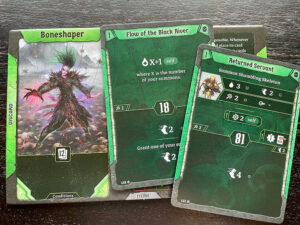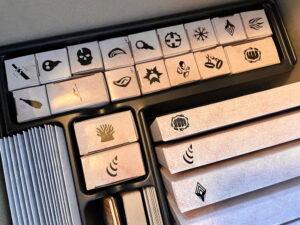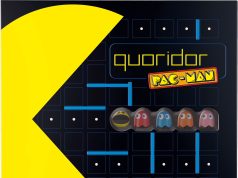 As a mercenary, days and nights can be filled with the most colorful adventures. Defeating all enemies in a room. Escorting an injured traveler to safety. Stopping a shadowy villain from taking over the world. All with the promise of payment, of course. Then there are the hours in between. Stuck wandering the streets of a struggling outpost in the middle of winter, or warming by the tavern fire, waiting for the next big—
As a mercenary, days and nights can be filled with the most colorful adventures. Defeating all enemies in a room. Escorting an injured traveler to safety. Stopping a shadowy villain from taking over the world. All with the promise of payment, of course. Then there are the hours in between. Stuck wandering the streets of a struggling outpost in the middle of winter, or warming by the tavern fire, waiting for the next big—
“Help! Help me!” What’s that? A call to action? We rise without thinking. There’s ever the hope that our exploits will also produce payment, but we can’t help ourselves in times like these. The adrenaline compels us forward. We rush into the harsh weather and follow the shouts to a nearby lean-to. What we find is unexpected, but at the same time, disappointing. No one makes a move to help Board Game Quest’s Brian, who’s being crushed under the massive box of the newest Cephalofair Games release, Frosthaven. We wince, knowing the weight must be excruciating.
“Come on guys, I can’t get out from under this thing.” We glance at each other and wonder what caused such an incident. Most of the mercenaries shake their heads and leave. Save for one who is up to the challenge.
Gameplay Overview:
Let’s get Gloomhaven out of the way. Love it or hate it, it remains an achievement in many ways. Did you ever play Gloomhaven? Did you finish it? If you answered yes, I have a feeling you are in the minority. Who has time to fully immerse themselves in a single campaign for months on end? We’re taking over 100 scenarios per campaign. And now that Frosthaven has arisen from the depths of crowdfunding, is there any reason to jump into Gloomhaven when another 100+ scenario campaign has emerged?

Frosthaven is even more ambitious than its brethren. It features many of the same rules and gameplay, but there are new additions such as town upgrades, crafting, seasonal (summer or winter) events, loot rewards, and more dynamic scenarios. It includes new characters to play (you can play the old here too), new stories to unlock, and new items to uncover. It also features many side scenarios featuring new content from board game content creators and designers.
How does one Frosthaven? It’s simple enough, even if the rules can become a bit convoluted at times. First, players must choose a starting character. Then they can go out into the icy elements and follow a scenario flowchart that shifts directions as players make important decisions. Yes, you will find yourself locked out of story pathways. Before beginning a scenario, players read a Road Event card that provides choices and may unlock additional story elements. More road events are seeded into their respective decks as the narrative progresses.
Once in a scenario, the game’s system scales to player count. This dictates how many monsters appear, including their health and power level. Early scenarios task players with killing all monsters to succeed, but these goals evolve as the campaign progresses. Setup includes map tiles and overlays dictated by the scenario guide. Typically, the initial room is visible whereas additional rooms are revealed as you enter via a separate section book.

Frosthaven is a card-based dungeon crawler. Each character has a hand limit, and each card features a central initiative number, as well as a top and bottom action. You can use a basic action of two attack or two move in place of any action printed on a card, but you’ll want to maximize the efficiency of your card abilities as they provide experience and elemental affinities for use by yourself or party members (or in an unfortunate case, your enemies) on future turns.
Players choose two cards to play per turn, one for its top action, and the other for its bottom action. Each round plays out via initiative order (monsters have their own decks with initiative and thematic abilities). At the end of a player’s hand of cards (or any time before), they can either short rest by removing a random card from the game to pick up their discard pile, or they can long rest to heal and lose a card of their choice.
Players either achieve the scenario goal or become exhausted and lose. Exhaustion comes in the form of running out of cards or by losing all health. An important rule is that players can negate damage by removing a card from the game. It brings you closer to the end, but it does allow you to live for another round.
A massive new inclusion is the post-scenario elements. Players may return to Frosthaven and read an Outpost Event card. These may include attacks that threaten the outpost, as well as story progression or narrative asides. Players return with resources gained during a scenario that can be utilized to build buildings, upgrade defenses and buildings, or even to craft items. As more buildings become unlocked, so does much of the nuance of Frosthaven’s resource economy.
There’s so much here that I’m not going to be able to cover without spoiling the journey. I do want to touch on characters though. Each character receives a personal quest. Once completed (typically ten to fifteen scenarios), a character must retire. Retirement allows players to try new classes and open sealed envelopes that contain all kinds of new elements, from rules to buildings to… well, other things. These also introduce new personal quests for future characters to pursue, as these can only be completed once per campaign.

Game Experience:
Full disclosure: I’ve not played Gloomhaven, though I’ve completed Gloomhaven: Jaws of the Lion. That said, I was aware of the system prior to jumping into Frosthaven and I did my due diligence by catching up on new gameplay elements, rules changes, or commonly misplayed rules. I’ve played about two-thirds of my first campaign (65 scenarios), a lot of that solo, though I was able to try scenarios at both two and three players. I have preferred to play solo with two characters to keep complexity down, and I’ve not adjusted beyond the normal difficulty.
With that out of the way, I must say that I’ve enjoyed my time so far. The narrative hasn’t been as undercooked as I would’ve expected, the scenario design has been interesting, and the characters are fun to master. I’ve been able to try eleven of the seventeen classes so far and all have provided their own complexities and power levels, though none (so far) have felt weak in any way. The six starting classes provide a great overview of what to expect as you stumble upon new classes as you progress.

Frosthaven can be difficult. The ticking time bomb of your dwindling hand of cards, coupled with enemies that provide a challenge at inopportune times, demands efficient play. Players can attempt scenarios again and they keep the experience gained when this happens, but it can be disappointing to lose on a final turn due to an unfortunate card draw. These scenarios take time to set up, explore, and survive. Thankfully you can always return to Frosthaven and try a different scenario until you are ready to return. There are several scenario options to choose from at any given moment.
To offset difficulty, players can opt into some of the provided variants or lower their difficulty level. I find that sometimes even a lower difficulty can still prove to be a challenge and there’s no shame in wanting to explore the breadth of the game before the inevitable next installment is announced. One would assume. I also suggest tweaking any rules that are holding your group back from progression, though without breaking the scenario challenge.

The new Outpost Phase provides a breath of fresh air, even if it can also stifle forward momentum. I like to explore my options and as the outpost grows, options increase for character gear and crafting. Other options eventually come into play as well which makes the outpost feel like a living space. It also provides plenty of avenues to utilize the resources collected along the way. The only area here that felt undercooked is defending the town, which tries its best to provide a side battle and resource sink. After a while, these just become a nuisance.
The card-based dungeon crawl continues to be the highlight. It’s the core gameplay element and can be a challenging puzzle, especially when playing with others. Timing initiative and enemy attacks with limited communication demand a strong party. The longer players can play together, the more they will see the strengths and weaknesses of their class combinations and learn which cards may appear in certain moments.
I do want to touch on a few areas that I find disappointing. First, I would never play this game without a helper app. There is an official companion app, but there are also others out there that provide their own benefits. Regardless of which you feel is right for you, these apps eliminate the need for so many components that make each scenario fiddly. I play without the element board, monster cards (abilities and modifiers), monster stats and sleeves, damage and condition tokens, and initiative tokens. That’s a lot of material that could’ve been left behind during production, making it a more compelling and efficient package.

Another thing that disappoints me is the lack of fail forward. I love the idea of completing a scenario without meeting its goals and having this change the course of the campaign. I do wish there was more of that here, rather than enduring scenario repetition for results. It would add nuance to the campaign narrative and make players feel even more invested in their actions.
One final note: the map tiles. Gloomhaven: Jaws of the Lion was a revelation. The atlas featured a printed map, allowing artists to create more unique settings and minimize setup time. Now, setup time here isn’t that bad (with the helper app), but again we’re talking about fewer components and more playtime. I understand that the map tiles and their repeated use throughout scenarios are a way to save on investing in unique locale development, but it’s another aspect that feels undercooked for a product with such a large budget.
Final Thoughts:
I’m excited for the final third of this campaign. I still have characters to explore. Locales to discover. Stories to unlock. I’ve not jumped into some of the building options nearly as much as I should have. I’d even admit that I’ve done a poor job of choosing my building upgrades over time as I find myself resource poor and contemplating repeating old scenarios for loot. But we trudge on. Into the wintery landscape, stumbling upon new creatures, new allies, sailing upon the seas, climbing rugged peaks, sledding across ice, always toward a massive conclusion. I can sense the end near. But there is still so much more to discover. And yes, we trudge on.
Well, almost all of us do. One has stayed behind, still attempting to lift the Frosthaven box off the struggling-for-breath body of one Brian, local purveyor of crowdfunded crafted items and not-so-proud owner of cracked ribs and crushed lungs. I do hope this box will budge soon. I’m giving it all I’ve got before I’m exhausted and out of options.
Final Score: 4 stars – Epic and at times overwhelming, Frosthaven improves upon its predecessors by taking small steps forward while staying true to its core.
 Hits:
Hits:
• Unique classes and combinations
• Scenario flowchart and seasonal calendar
• Multiple unfolding narratives
• Player scaling
Misses:
• Unnecessary components
• Lack of app integration
• No fail forward
• Optional JotL-style scenario maps






















If you lose a scenario you get to keep the XP and loot you gained. Seems like a fail forward option to me.
That is true. But not necessarily what I was trying to highlight. Scenario repetition may be enjoyable for some, but it lacks a certain narrative dynamic. Not that the “Haven” games have a spectacular narrative space, but motivation is important. I hope the scenario design continues to grow as this system evolves over time. Character progression within the system is just as important, as you mentioned.
You can only do so much with a board game I think failing forward is not possible without the consequence of a Game Over. You can only lose so much without being truly punished for not completing core quests.